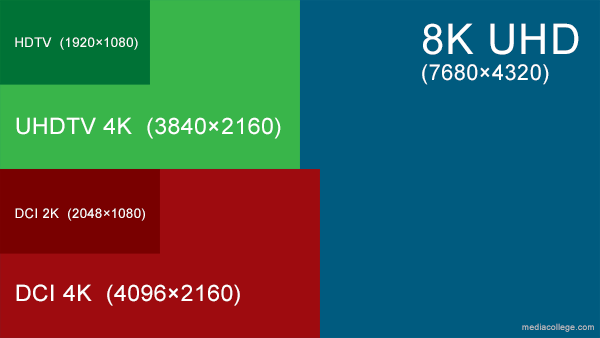4K Resolution
Dave Owen explains 4K in this video.
4K resolution refers to an image or display that contains approximately 4,000 horizontal pixels. There are currently two main variations of the 4K format, one designed for television and one designed for digital cinemas:
- UHD 4K (television, 3840×2160 pixels)
- DCI 4K (cinema, 4096×2160 pixels)
The diagram below compares these resolutions to previous-generation formats for television (green) and cinema (red). Notice that cinema resolutions are the same height but slightly wider than their equivalent television resolutions. 8K is a proposed standard that is not yet commercially available.

Green = Television, Red = Cinema, Entire box = 8K.
UHD Television
UHDTV (Ultra high definition television) consists of two television formats intended to supersede HDTV, and approved by the International Telecommunication Union (ITU). UHD 4K is the first of these two formats; 8K is proposed for the future.
DCI (Digital Cinema)
The Digital Cinema Initiatives consortium has defined two resolutions for digital cinemas: 2K and 4K.
The first generation of digital cinema in the early 2000s was mostly 2K resolution. 4K has grown in popularity since the early 2010s. The Girl With the Dragon Tattoo (2011) was one of the first major films to be produced and distributed in 4K.
4K is currently being adopted by more filmmakers and cinemas but it's likely that 2K films will continue to be a standard for some time yet.
3D & 4K
Because 3D requires so much more visual information, 3D films are likely to stick with 2K for the foreseeable future.
LCD vs OLED
The first generation 4K TVs are LCD but several manufacturers have shown prototypes of OLED models.
4K Content for TV & Home Cinema
Apart from the initial price of a 4K TV, the obvious problem for early adopters is the lack of content. Television broadcasts won't be going 4K in the foreseeable future and there are currently no practical distribution options. At the 2013 CES Sony announced a trial initiative to provide 4K movies on media servers, but this doesn't appear to be a good long-term solution.
The other option is "upscaling", in which lower resolutions are interpolated on-the-fly to create higher resolutions. Sony has also announced an enhanced Blu-ray format that plays 1080p but is optimized for 4K upscaling.
Online, 4K is making slow but steady gains. YouTube offers 4K as downloadable files—the player does not yet support 4K playback. Netflix has been working with Samsung to provide 4K but early reports about its quality have been less than favorable.
More 4K content is likely to be released by independent producers over the next few years.
Other Applications
It's likely that many early adopters of 4K will use it for something other than watching movies. The larger screens would be a viable option for many public display situations, and at home a 2m (84") 4K display would make a nice monitor for gaming and computer applications.